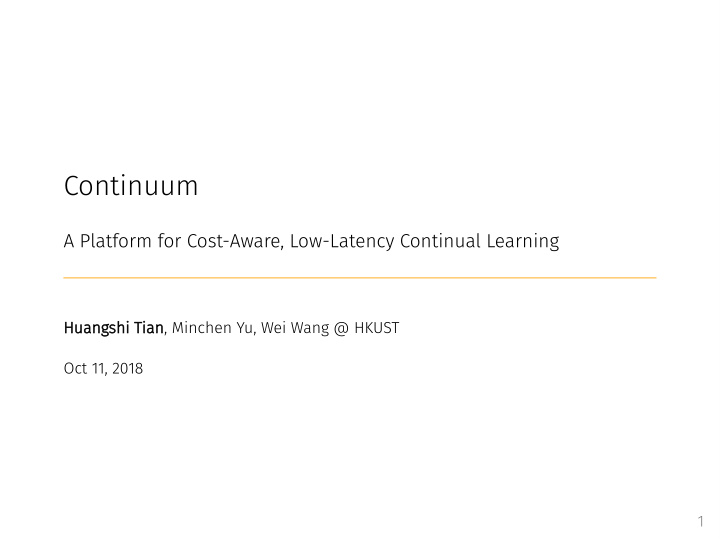



Continuum A Platform for Cost-Aware, Low-Latency Continual Learning Huangshi Tian, Minchen Yu, Wei Wang @ HKUST Oct 11, 2018 1
Continual/Online vs. Batch/Offline Learning When fresh data arrive, offline / batch offline learning trains model + from scratch with all learning historical data; fresh data historical data updated model online / continual online learning updates + model with fresh data. learning stale model fresh data updated model 2
Case Study: Topic Monitoring Scenario Users continuously generate tweets; tweets users data servers We deploy topic models to detect new topics; Continual Learning System Topic models are + continually updated prediction servers with new data. Setting AWS EC2 (c5.4xlarge instance) Latent Dirichlet Allocation (LDA) and a dataset of real-world tweets 3
Case Study: Topic Monitoring Results Perplexity measures the model quality (lower means better). Incorporating fresh data improves model quality. Online updating takes much less time than offline retraining. 4
Advantage of Online Learning better performance quickly exploit data recency to improve model quality consume less hardware resources wide application in industry : recommendation, contextual decision makin, click-through rate prediction , , : online advertising 5
Why do we need a platform? no support from mainstream learning systems ad-hoc scripts bacome status quo This becomes particularly challenging when data changes over time and fresh models need to be produced continuously. Unfortunately, such orchestration is often done ad hoc using glue code and custom scripts developed by individual teams for specific use cases, leading to duplicated effort and fragile systems with high technical debt. —Google 6
Why do we need a platform? wasted effort in (re)implementing training loop Lines of Code in Case Studies Application Training Loop Model Updating Topic Monitoring 377 56 Friend Suggestion 211 41 Click Prediction 558 44 7
In need of a general-purpose, automated solution for continual learning, we present Continuum 8
System Overview automated: streamlines the process of online learning general-purpose: applicable to heterogeneous ML frameworks and systems lightweight: a thin layer on existing systems 9
Overall Workflow 10
Overall Workflow 11
When to Retrain Models? Setting: As data keep arriving, Continuum determines when to retrain models. 12
When to Retrain Models? Setting: As data keep arriving, Continuum determines when to retrain models. 13
When to Retrain Models? Setting: As data keep arriving, Continuum determines when to retrain models. 14
When to Retrain Models? Setting: As data keep arriving, Continuum determines when to retrain models. Objectives better model quality → minimize data incorporation latency less hardware cost → minimize training cost (i.e., machine time) 15
Scenario I: Seeking Fast Data Incoporation Naive Approach: Continuous Update 16
Scenario I: Seeking Fast Data Incoporation Naive Approach: Continuous Update 17
Scenario I: Seeking Fast Data Incoporation Naive Approach: Continuous Update 18
Scenario I: Seeking Fast Data Incoporation Naive Approach: Continuous Update 19
Scenario I: Seeking Fast Data Incoporation Naive Approach: Continuous Update Proposed Approach: Best-Effort Policy 20
Scenario I: Seeking Fast Data Incoporation Naive Approach: Continuous Update Proposed Approach: Best-Effort Policy 21
Scenario I: Seeking Fast Data Incoporation Naive Approach: Continuous Update Proposed Approach: Best-Effort Policy 22
Scenario I: Seeking Fast Data Incoporation Naive Approach: Continuous Update Proposed Approach: Best-Effort Policy Potential Problem: high training cost because the machine is always occupied 23
Scenario II: Saving Cost of Training Naive Approach: Periodic Update Proposed Approach: Cost-Aware Policy a regret-based online algorithm jointly optimize the weighted sum of latency and training cost proven to be 2-competitive (never worse than twice the offline optimum) 24
Experimental Setting Testbed AWS EC2 (c5.4xlarge instance) Applications Latent Dirichlet Allocation (LDA) from Mallet + twitter dataset Gradient-Boost Decision Tree (GBDT) from XGBoost + Criteo click dataset Personalized PageRank (PPR) + twitter user dataset Methodology Replay data generation and update models under different policies. Metrics incorporation latency of all data samples training cost measured by machine time 25
Evaluation of Proposed Policies Compared with Continuous Update , Best-Effort Policy can reduce the latency by up to 15.2%. Compared with Periodic Update , Cost-Aware Policy can reduce the latency by up to 28%, saves hardware cost by up to 32%. 26
Evaluation of Implemented System Continuum achieves high effi ficiency in responding to requests and deciding to update models, linear scalability to a 20- node cluster, low overhead imposed on backend. 27
Conclusion motivate the need of an online learning platform design and implement Continuum propose two policies for fast data incorporation and low cost 28
Source code available at Thanks for your attention! 29
Customized Policy For users who want to decide when to retrain on their own, we provide two mechanisms. REST API to trigger retraining Users can leverage external information (cluster usage, model monitor). Example: When model quality drops below a threshold, retrain the model. abstract policy class for extension Users can access internal information (data amount, estimated training time). Users can implement their own decision logic. 30
Backend Abstraction Continuum communicates with backends through an RPC layer. The following interface abstracts away the heterogeneity of learning frameworks and systems. 31
Recommend
More recommend